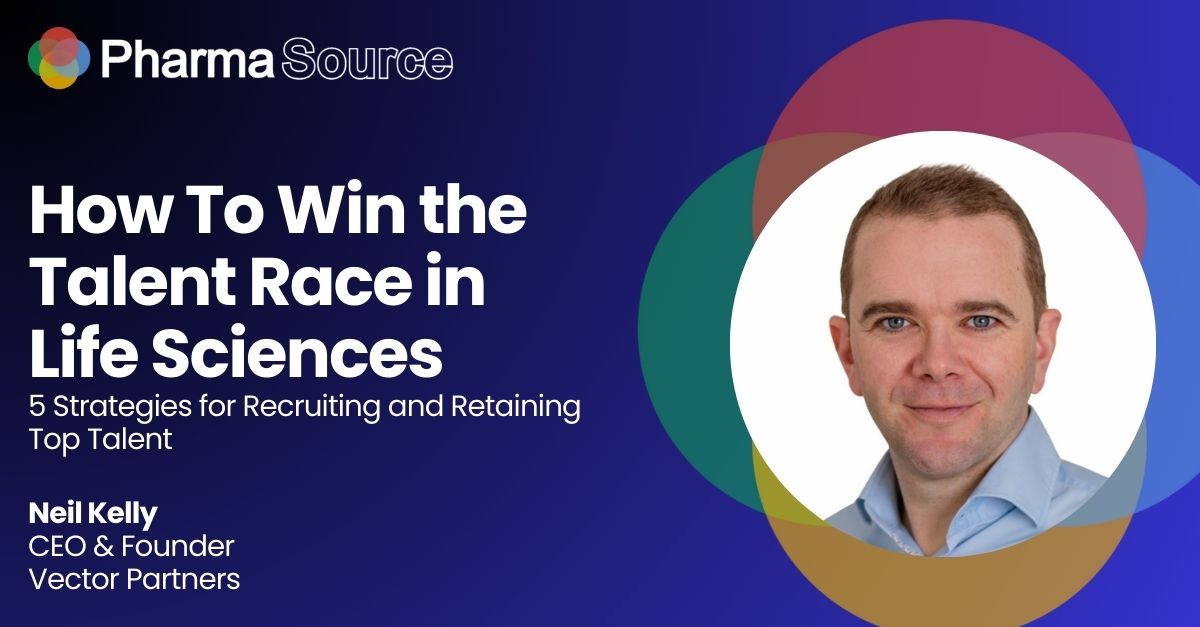“One of the challenges we face is trying to recruit talent in a market that is short on the skills we require. There’s a major shortage of talent,”
Neil Kelly, founder of Vector Partners, has two decades of experience in talent acquisition within life sciences, including a building teams at Thermo Fisher and Patheon over a period that saw the company scale significantly.
The market has never been more competitive, he says. “There are more roles in the market than there have ever been before, with many new roles tcreated by digital innovation that weren’t around five years ago.”
In the latest episode of the PharmaSource podcast Neil explains some key strategies to help supply chain and procurement leaders to bridge the talent gap in life sciences.
1. Reassess on-site vs remote talent
The great lesson from the pandemic was been the successful continuation of business through remote working.
“The supply chain has become more and more global” says Neil. “As you think around talent and your workforce globally, you then start realising that it’s not so much about where the product is that’s important – but where you can source the talent.”
This has presented a real challenge for HR and talent functions who need to understand which roles can go remote versus those that simply can’t – such as manufacturing or logistics roles that physically handle products.
“Don’t think about physical distance as a limitation to trade or to doing business together.” says Neil. “The pandemic has shown that doing deals remotely is very possible. The major benefit is the environmental impact, but also speed so we can get deals closed faster.”
“Start to look globally for where you source talent, versus where you need to produce the product.”
2. Go deeper into a candidates’ strengths and weaknesses
If it’s challenging to find someone who is an exact fit, go look deeper into a candidate’s strengths, says Neil.
“There are very few dedicated academic courses for sourcing, procurement and supply chain, and those that are can be very dated in terms of the content that’s delivered to students. So we have to look elsewhere.”
“If particular talent doesn’t exist in the market, we have bypass what the label of the degree says on their resume and really start to look at who they are as an individual and their behaviours. Do they understand the science that the organisation is trying to deliver?”
“Can you take a scientist and make them into procurement person, or take a scientist and put them in supply chain? The answer is ‘yes’, but only if they’ve got the right strengths and behaviours in areas such as communication and leadership.”
3. Invest in skills development
“Skills development will continue to be paramount for organisations moving forward, certainly for the next two to three years minimum.” says Neil, poinitng out that it’s not only a great retention tool, but it also allows you to upskill your existing team.
“If you take an average procurement function or supply chain function, very often, they will have a defined set of skills and a defined boundaries in terms of where they operate.
Training can help you to get “more all-rounders in your business”, which will increase your productivity and “is a good thing for the employee, and a good thing for the business.”
4. Recruit from outside of the industry
“You can’t train the science” says Neil, but enabling functions such as procurement and supply chain – similar to HR and finance – do have transferable skills which you can look for outside of the life sciences industry.
“In supply chain, we look for agility, speed, and sharpness around commerciality that generally has not come from within the pharma industry. “
“We can source that talent from those industries that are really lean. The telecoms and third-party logistics industries really ‘sharpen their pencil’ around some of these skills. We go into these industries and pluck out the very best.”
5. Use compensation to your advantage
Take the opportunity to use pay and benefits as way to attract talent from other industries.
“Compensation is generally lower within these industries (such as telecoms and third-party logistics) than in pharma, so you can use this to attract the right talent. There’s a commercial or a compensation advantage of attracting someone.”
Listen to the full podcast for the full interview with Neil Kelly, and head to the Vector Partners website for more information on their services..











